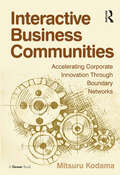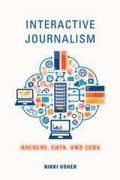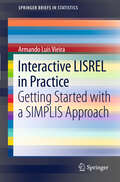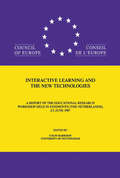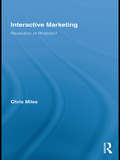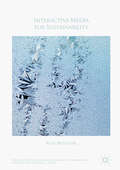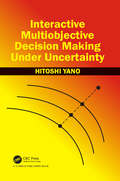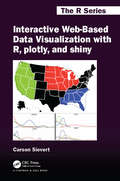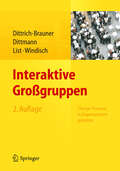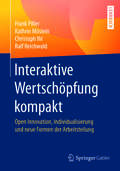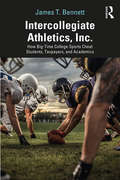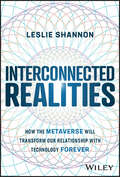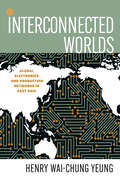- Table View
- List View
Interactive Business Communities: Accelerating Corporate Innovation through Boundary Networks
by Mitsuru KodamaInnovation in technology and services was once the result of specialist knowledge developed within a single corporation; now, a single focus on the development of new products and services is no longer enough. In Interactive Business Communities, Mitsuru Kodama shows how a new business approach can enable managers to access, share and integrate diverse knowledge both inside and outside the corporation using Boundary Networks to operate across more formal organizational and knowledge boundaries at all levels. Drawing on his studies of large corporations in America and the Far East, Mitsuru, shows how different companies have already started to take this path. He explains the kind of networks and strategic partnerships that have emerged and gives practical guidelines on how to begin forming in-house business communities and extending this to interactive business communities with customers and other organizations. This book is a valuable resource for business educators and researchers, and senior executives responsible for strategy, particularly in high-tech industries, will find insights and ideas to tackle 21st century market and business discontinuities.
Interactive Control Systems: Adapting to Competitive Environments
by Robert L. SimonsManaging the tension between creative innovation and predictable goal achievement is the essence of management control. This chapter looks at how senior managers use interactive control systems to build internal pressure to encourage the emergence of new strategic initiatives.
Interactive Decision Aids in E-Commerce
by Jella PfeifferThis book gives recommendations on which interactive decision aids to offer in webstores. Interactive decision aids are tools that help online shoppers to compare and evaluate product information. Consumers can, for instance, exclude products that do not meet certain criteria, they can highlight certain information or they can assign ratings of different kinds. Interactive decision aids are important, because finding the preferred product in a short amount of time increases both the customers' satisfaction and, in turn, the sales volume.This book includes a detailed description of decision aids, closely studies how decision aids are related to the decision behavior of customers, and develops a comprehensive system of decision aids, which is very flexible, increases both customer satisfaction and confidence, and can be used intuitively. The close link between typical behaviors and the decision aids allows webstores to learn about customers' decision-making behavior by using a simple click stream analysis. The book is written in an easy-to-read style and provides both practical recommendations and knowledge about consumer behavior
Interactive Journalism: Hackers, Data, and Code
by Nikki UsherInteractive journalism has transformed the newsroom. Emerging out of changes in technology, culture, and economics, this new specialty uses a visual presentation of storytelling that allows users to interact with the reporting of information. Today it stands at a nexus: part of the traditional newsroom, yet still novel enough to contribute innovative practices and thinking to the industry. Nikki Usher brings together a comprehensive portrait of nothing less than a new journalistic identity. Usher provides a comprehensive history of the impact of digital technology on reporting, photojournalism, graphics, and other disciplines that define interactive journalism. Her eyewitness study of the field's evolution and accomplishments ranges from the interactive creation of Al Jazeera English to the celebrated data desk at the Guardian to the New York Times' Pulitzer-endowed efforts in the new field. What emerges is an illuminating, richly reported portrait of the people coding a revolution that may reverse the decline and fall of traditional journalism.
Interactive LISREL in Practice: Getting Started with a SIMPLIS Approach
by Armando Luis Vieira"Getting Started with a SIMPLIS Approach" is particularly appropriate for those users who are not experts in statistics, but have a basic understanding of multivariate analysis that would allow them to use this handbook as a good first foray into LISREL. Part I introduces the topic, presents the study that serves as the background for the explanation of matters, and provides the basis for Parts II and III, which, in turn, explain the process of estimation of the measurement model and the structural model, respectively. In each section, we also suggest essential literature to support the utilization of the handbook. After having read the book, readers will have acquired a basic knowledge of structural equation modeling, namely using the LISREL program, and will be prepared to continue with the learning process.
Interactive Learning & The New
by Colin HarrisonThis book compares research findings on particular topic of interactive learning to identify areas of research, and discusses possibilities of research co-operation. It presents an argument that in the UK the emphasis on small group work using a microcomputer is the result of pedagogical opinion.
Interactive Learning for Innovation
by Bjørn T. Asheim Mario Davide ParrilliThis collection of essays challenges the traditional neoclassical approach to innovation and growth, focusing on interactive and experiential innovation, and reaffirming the importance of science and technology as a means of mutual strengthening. Through a detailed examination of the performanceof geographical areas of outstanding economic growth, this volume responds to the needs of economies with limited financial capacity for investment in standard knowledge-based inputs and human capital. Contributions instead emphasise the potential for innovation and development in practical and technological areas, providing valuable policy lessons for SME-based economies.
Interactive Marketing: New Channel, New Challenge
by Richard LueckeE-mail and Web-based merchandising are the key forms of Internet marketing. E-mail campaigns build customer relationships, drive sales, and begin valuable customer service when purchases have been made. Web site merchandising gives vendors a direct link with customers, eradicating the retail middlemen and retail overhead. And although snares do exist in Internet marketing, this chapter focuses on how to capitalize fully on Web-based options.
Interactive Marketing: Revolution or Rhetoric? (Routledge Interpretive Marketing Research)
by Christopher MilesThis book critically examines the rhetoric surrounding current trends in the adoption of tropes of interactivity in marketing communication. Concepts such as viral advertising, customer-generated content, brand communities and the whole panoply of Web 2.0-mediated marketing technologies all have their foundations in an overt positioning of interactivity as the savior of effective marketing communication. Yet, what exactly is meant by interactivity in these contexts and how far does it represent a revolution in the methodologies of marketing? Anchoring his analysis in a critique of the assumptions of control embedded in current marketing communication models and the rhetorical analysis of exemplar texts from the Marketing Management, Customer Relationship Management, Viral Marketing and Buzz Marketing paradigms, Chris Miles investigates the constructions and reconstructions of discourse that surround the uses of interactivity in contemporary marketing discourses. In doing so, he offers a radical new model of marketing based upon a recursive, constructivist understanding of communication that uses metaphors of invitation and exploration to rebuild interactivity at the center of marketing. The work culminates in a reading of the theory of Relationship Marketing that uses autism as an allegory to interrogate the communicative paradox at the heart of this contemporary marketing panacea.
Interactive Media for Sustainability (Palgrave Studies in Media and Environmental Communication)
by Roy BendorInteractive Media for Sustainability presents a conceptually rich, critical account of the design and use of interactive technologies to engage the public with sustainability. Treating interactive technologies as forms of mediation, the book argues that these technologies advance multiple understandings of sustainability. At stake are the ways sustainability encodes the complexity of interrelated social and natural systems, and how it conveys the malleability of the future. The book’s argument is anchored in a diverse set of theoretical resources that include contemporary work in human-computer interaction (HCI), social theory, media studies, and the philosophy of technology, and is animated by a variety of examples, including interactive simulations, persuasive apps, digital games, art installations, and decision-support tools.
Interactive Multiobjective Decision Making Under Uncertainty
by Hitoshi YanoRecently, many books on multiobjective programming have been published. However, only a few books have been published, in which multiobjective programming under the randomness and the fuzziness are investigated. On the other hand, several books on multilevel programming have been published, in which multiple decision makers are involved in hierarchical decision situations. In this book, we introduce the latest advances in the field of multiobjective programming and multilevel programming under uncertainty. The reader can immediately use proposed methods to solve multiobjective programming and multilevel programming, which are based on linear programming or convex programming technique. Organization of each capter is summarized as follows. In Chapter 2, multiobjective programming problems with random variables are formulated, and the corresponding interactive algorithms are developed to obtain a satisfactory solution, in which the fuzziness of human's subjective judgment for permission levels are considered. In Chapter 3, multiobjective programming problems with fuzzy random variables are formulated, and the corresponding interactive algorithms are developed to obtain a satisfactory solution, in which not only the uncertainty of fuzzy random variables but also the fuzziness of human's subjective judgment for permission levels are considered. In Chapter 4, multiobjective multilevel programming is discussed, and the interactive algorithms are developed to obtain a satisfactory solution, in which the hierarchical decision structure of multiple decision makers is reflected. In Chapter 5, two kinds of farm planning problems are solved by applying the proposed method, in which cost coefficients of crops are expressed by random variables.
Interactive Networks: Determining the Right Degree of Creative Tension to Support Business Strategy
by Robert L. SimonsIn this chapter, the author explains how to manage creative tension--one of the four Cs of organization design--to facilitate the required levels of interunit communication, learning, and adaptation that support the implementation and evolution of strategy.
Interactive Robotics: Selected Contributions to the INBOTS Conference 2021, 18-20 May, 2021 (Biosystems & Biorobotics #30)
by María Amparo Grau RuizThis book reports on cutting-edge legal, ethical, social and economic issues relating to robotics and automation, human-machine interaction and artificial intelligence, in different application areas. It discusses important problems such as robotic taxation, social inequality, protection of neuro-human and children rights, among others. It describes current advances and challenges in robotic regulation and governance, as well as findings relating to sustainability of robotic industries, thus filling an important gap in the robotic and AI literature. Chapters consists of revised and extended contributions to the workshop session “Debate on legal, ethical & socio-economic aspects of interactive robotics” of INBOTS 2021, held virtually on May 18-20, 2021.
Interactive Web-Based Data Visualization with R, plotly, and shiny (Chapman & Hall/CRC The R Series)
by Carson SievertThe richly illustrated Interactive Web-Based Data Visualization with R, plotly, and shiny focuses on the process of programming interactive web graphics for multidimensional data analysis. It is written for the data analyst who wants to leverage the capabilities of interactive web graphics without having to learn web programming. Through many R code examples, you will learn how to tap the extensive functionality of these tools to enhance the presentation and exploration of data. By mastering these concepts and tools, you will impress your colleagues with your ability to quickly generate more informative, engaging, and reproducible interactive graphics using free and open source software that you can share over email, export to pdf, and more. Key Features: Convert static ggplot2 graphics to an interactive web-based form Link, animate, and arrange multiple plots in standalone HTML from R Embed, modify, and respond to plotly graphics in a shiny app Learn best practices for visualizing continuous, discrete, and multivariate data Learn numerous ways to visualize geo-spatial data This book makes heavy use of plotly for graphical rendering, but you will also learn about other R packages that support different phases of a data science workflow, such as tidyr, dplyr, and tidyverse. Along the way, you will gain insight into best practices for visualization of high-dimensional data, statistical graphics, and graphical perception. The printed book is complemented by an interactive website where readers can view movies demonstrating the examples and interact with graphics.
Interaktionen mit Social Media Influencern als Instrument zur Markenprofilierung (Innovatives Markenmanagement)
by Jana HiddessenIn der Unternehmenspraxis wird die Profilierung von Markenimages aufgrund der stetig steigenden Markenvielfalt zunehmend schwieriger. Immer mehr Unternehmen kooperieren inzwischen mit Social Media Influencern, um Marken von den Online-Meinungsführern bewerben zu lassen und dadurch ein möglichst prägnantes Markenimage im Gedächtnis der Konsumenten zu verankern. Dabei hebt sich dieses innovative Kommunikationsinstrument insbesondere durch den hohen Interaktionsgrad von traditionellen Massenmedien ab.Jana Hiddessen geht der Fragestellung nach, inwiefern sich markenbezogene Interaktionen mit Social Media Influencern als Instrument zur Markenprofilierung eignen. Sie analysiert dabei den differenzierten Wirkbeitrag unterschiedlicher Arten markenbezogener Aktivitäten mit Social Media Influencern auf das Markenimage sowie nachgelagerte Zielgrößen der Markenführung. Aus den empirischen Erkenntnissen ergeben sich praxisorientierte Handlungsempfehlungen für das Markenmanagement.
Interaktionsspiele bei Psychopathie: Antisoziale Manipulation erkennen und konstruktiv bewältigen (Psychotherapie: Praxis)
by Rainer Sachse Fritjof von FranquéIm vorliegenden Buch wird beschrieben, wie manipulatives Handeln von Personen mit Psychopathie erkannt und bewältigt werden kann. Die psychopathische Persönlichkeitsstörung (engl.: Psychopathy) ist definiert durch eine Kombination aus interaktionellen, affektiven, antisozialen und sich im Lebensstil ausdrückenden Besonderheiten, zu denen Egozentrizität, manipulierendes Verhalten, ein Mangel an Mitgefühl, Schuld und Reue, pathologisches Lügen, Verantwortungslosigkeit sowie die kontinuierliche Verletzung sozialer Normen und Erwartungen zählen. Fachleute haben vor allem Schwierigkeiten, mit den interpersonellen Merkmalen dieser Störung umzugehen. Dieses Buch bietet hierfür konkrete Unterstützung. Geschrieben für … Psychotherapeuten, Coaches, Diagnostiker, Psychiater, forensische Psychologen und alle, die beruflich mit Psychopathen zu tun haben. Die Autoren: Prof. Dr. Rainer Sachse ist Psychologischer Psychotherapeut, Begründer der „Klärungsorientierten Psychotherapie“ und Leiter des Instituts für Psychologische Psychotherapie (IPP) in Bochum. Fritjof von Franqué ist sexualforensischer Psychotherapeut und leitender Psychologe am Institut für Sexualforschung und Forensische Psychiatrie des Universitätsklinikums Hamburg-Eppendorf (UKE).
Interaktive Einkaufserlebnisse in Innenstädten: Digitale Dienstleistungen mit der smartmarket²-Plattform
by Jörg Becker Gertrud Schmitz Daniel Beverungen Andera GadeibDie Digitalisierung ist für den stationären Einzelhandel Chance und Bedrohung zugleich. Nicht zuletzt hat die Pandemie den Wettbewerbsdruck verschärft, aber auch den Wert der Innenstadt für unsere urbane Lebensqualität ins Bewusstsein gerückt. Basierend auf neuesten digitalen Technologien werden konkrete Perspektiven für den stationären Einzelhandel der Zukunft entworfen. Digitale Einkaufserlebnisse können die Stärken des Handels betonen und ergänzen. Zu ihrer Umsetzung werden mobile Applikationen sowie eine digitale Plattform vorgestellt. Im Rahmen zweier Feldstudien wurden diese Maßnahmen in einer mittelgroßen Innenstadt umfassend umgesetzt und ausgewertet.Das Buch liefert stationären Einzelhändlern und Städten somit konkrete Empfehlungen und Umsetzungshilfen, wie sie die Digitalisierung des stationären Handels meistern und die Zukunft einer lebendigen Innenstadt nachhaltig sichern können.
Interaktive Großgruppen: Change-Prozesse in Organisationen gestalten
by Carmen Windisch Volker List Karin Dittrich-Brauner Eberhard DittmannOrganisationen und ihre Mitarbeiter verändern sich fortlaufend und lernen dazu, um konkurrenzfähig zu bleiben. Zu diesem Zweck setzen Unternehmen immer häufiger Großgruppenverfahren ein, denn diese haben klassischen Workshopmethoden einiges voraus: Sie erzeugen Bewegung, initiieren Kontakte und Diskussionen, fördern die Identifikation und garantieren die Nachhaltigkeit von Veränderungen in Organisationen - kurz: sie binden auf aktive und effektive Weise viele Menschen in einen gemeinsamen Entwicklungsprozess ein. Die Arbeit mit großen Gruppen ist gleichzeitig zielführend und unterhaltsam. Alles drin: Zum einen "klassische Verfahren" wie Zukunftskonferenz, Open Space, Appreciative Inquiry, RTSC, World Café, sowie deren Entwicklung, Einsatzgebiete, Ablauf und Nutzen. Zum anderen Weiterentwicklungen und Trends, neue Anforderungen, integrative Ansätze, Einbindung neuer Technologien u.v.m., sowie Tipps zur Dramaturgie in Großgruppen. Direkt loslegen: Mit konkreten Tipps, Checklisten, Experteninterviews, Fallbeispielen und Erfahrungsberichten aus bekannten Unternehmen, Hinweisen zu speziellen Einsatzmöglichkeiten von Großgruppenverfahren und, damit nichts schiefgeht, Vorbereitungs-Tipps zu Räumlichkeiten, Ton, Visualisierung, Dokumentation und Zeitplanung. Die zweite Auflage wurde aktualisiert und um aktuelle Themen (u.a. Social Media, Großgruppen in Veränderungsprojekten) ergänzt.
Interaktive Wertschöpfung kompakt: Open Innovation, Individualisierung und neue Formen der Arbeitsteilung
by Frank Piller Ralf Reichwald Kathrin Möslein Christoph IhlDieses Lehrbuch vermittelt in komprimierter Form die wesentlichen Inhalte des Standardwerkes“ Interaktive Wertschöpfung“ von Ralf Reichwald und Frank Piller. Unternehmerische Wertschöpfung findet heute zunehmend nicht mehr sequentiell im Sinne einer klassischen Wertschöpfungskette statt, sondern interaktiv und iterativ zwischen einem fokalen Unternehmen und externen Mitwirkenden. Vor allem Kunden und Nutzer werden selbst aktiv (Co-Creation). Dies gilt für die Forschung und Entwicklung neuer Produkte und Dienstleistungen (Open Innovation) genauso wie für operative Wertschöpfungsprozesse (Mass Customization). Die Zusammenarbeit zwischen Unternehmen und Externen wird dabei in vielen Fällen anders organisiert. Statt Aufgaben zu verteilen bzw. anzuweisen, reagieren die Beitragenden auf einen offenen Aufruf zur Mitwirkung und selektieren selbst, wann und wie sie sich beteiligen (Crowdsourcing). Die erweiterte Co-Autorenschaft mit Frank Piller, Kathrin Möslein, Christoph Ihl und Ralf Reichwald bildet für die Weiterentwicklung dieses Buches eine neue konzeptionelle Basis. .
Interchange Fee Economics: To Regulate or Not to Regulate?
by Jakub GórkaInterchange fees have been the focal point for debate in the card industry, among competition authorities and policy makers, as well as in the economic literature on two-sided markets and on the regulation of market failures. This book offers insight into the economics of interchange fees. First, it explains the nature of two-sided markets/platforms/networks and elaborates on four-party schemes and on the rationale behind interchange fees according to Baxter’s model and its later refinements. It also includes the debate about the optimum level of interchange fees and its determination (“tourist test”), and presents the original framework for assessing the impact of interchange fee regulatory reductions for the market participants: consumers, merchants, acquirers, issuers, and card organisations. The framework addresses three areas of concern in reference to the transmission channels of interchange fee reductions (pass-through) and the card scheme domain (triangle: payment organisation, issuer, acquirer). The book discusses the effects of regulatory interchange fee reductions in Australia, USA, Spain, and, most specifically, Poland. It will be of interest to policy makers, card and payments industry practitioners, academics, and students.
Interco
by Susan L. Roth Scott P. MasonInterco has been advised by Wasserstein Perella to reject a $70 per share offer for the company. The case deals with the various types of analysis employed by Wasserstein Perella and allows a discussion of the actions of Interco's board as well as Wasserstein Perella.
Intercollegiate Athletics, Inc.: How Big-Time College Sports Cheat Students, Taxpayers, and Academics
by James T. BennettIntercollegiate Athletics, Inc. examines the corrupting influence and damaging financial effects of big-time intercollegiate athletics, especially football and to a lesser extent basketball, on American higher education. Including historical and contemporary perspectives, the book traces the growth of intercollegiate sports from largely student-run activities supervised by faculty to the gargantuan, taxpayer-supported spectacles that now dominate many public universities. It investigates the regressive student fees that have helped subsidize big-time sports at public universities and prop up chronically unprofitable athletic departments, as well as the corrosive effects of athletics on the university’s academic enterprise. A review of the alleged salutary effects of massive sports programs, such as spurring alumni donations and student applications, reveals that such benefits are largely illusory, more myth than real. The book also pays special attention to the often prescient, if largely unsuccessful, opponents of these developments, and considers the alternatives to big-time athletics, from abolition to professionalization to club sports. Students, scholars, sports fans, and those interested in learning how big-time football and basketball have cast such an enormous—and often baleful—shadow upon American colleges and universities will profit from this provocative and engagingly written book.
Intercon Japan
by Kazuhiro Mishina Marie-Therese FlahertyDescribes the many international sourcing initiatives in a multinational connector manufacturing company from the standpoint of an independent and very successful subsidiary in Japan. Students can explore the conflicts inherent in the situation and thus the more general motives for centralization and decentralization in international manufacturing companies. Japanese purchasing methods and vendor relations are also presented in great detail.
Interconnected Realities: How the Metaverse Will Transform Our Relationship to Technology Forever
by Leslie ShannonExplore how the metaverse is changing our livesIn Interconnected Realities, Leslie Shannon, Head of Trend and Innovation Scouting at Nokia, delivers an energizing and optimistic new take on the Metaverse. Starting with metaverse realms already in existence today, the book explores the purpose that each independent platform serves, as well as how all these disparate realms will ultimately be stitched together to permanently transform our personal and business lives. A singularly insightful and informed exploration of a fascinating subject at the intersection of technology, business, and society, Interconnected Realities is an essential resource for executives, managers, board members, and other business leaders at companies in a wide range of industries, as well as tech enthusiasts, futurists, and anyone with an interest in the future of social interaction, business, or technology.
Interconnected Worlds: Global Electronics and Production Networks in East Asia (Innovation and Technology in the World Economy)
by Henry Wai-Chung YeungThe global electronics industry is one of the most innovation-driven and technology-intensive sectors in the contemporary world economy. From semiconductors to end products, complex transnational production and value-generating activities have integrated diverse macro-regions and national economies worldwide into the "interconnected worlds" of global electronics. This book argues that the current era of interconnected worlds started in the early 1990s when electronics production moved from systems dominated by lead firms in the United States, Western Europe, and Japan towards increasingly globalized and cross-macro-regional electronics manufacturing centered in East Asia. By the 2010s, this co-evolution of production network complexity transformed global electronics, through which lead firms from South Korea, Taiwan, and China integrated East Asia into the interconnected worlds of electronics production across the globe. Drawing on literature on the electronics industry, new empirical material comprising custom datasets, and extensive personal interviews, this book examines through a "network" approach the co-evolution of globalized electronics production centered in East Asia across different national economies and sub-national regions. With comprehensive analysis up to 2021, Yeung analyzes the geographical configurations ("where"), organizational strategies ("how"), and causal drivers ("why") of global production networks, setting a definitive benchmark into the dynamic transformations in global electronics and other globalized industries. The book will serve as a crucial resource for academic and policy research, offering a conceptual, empirically driven grounding in the theory of these networks that has become highly influential across the social sciences.
